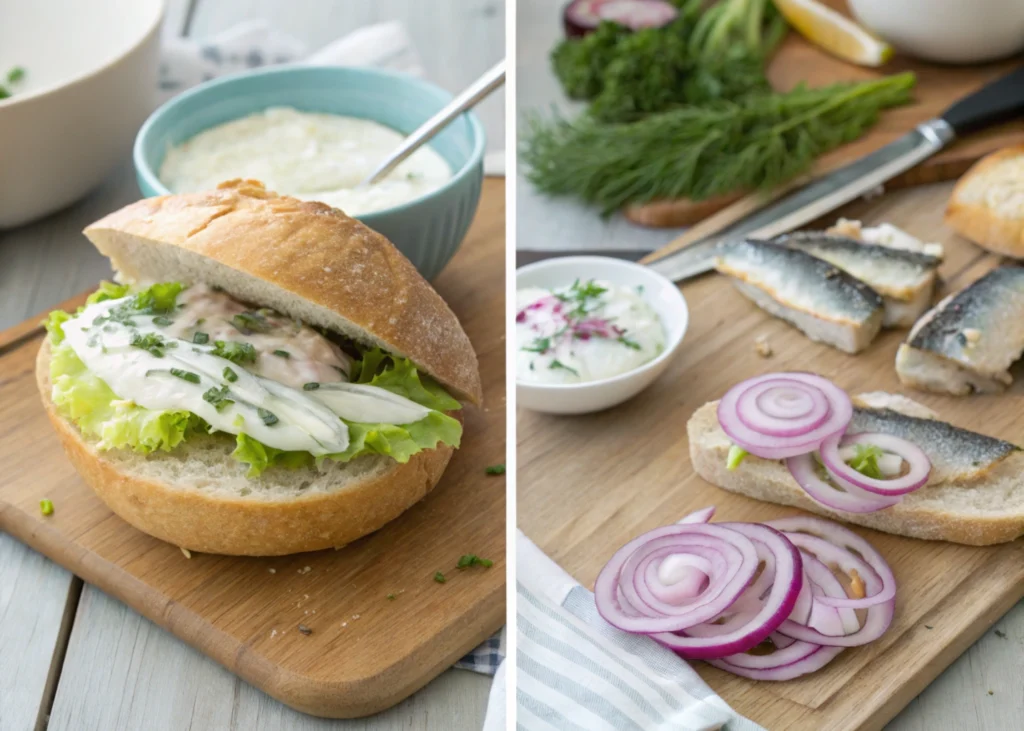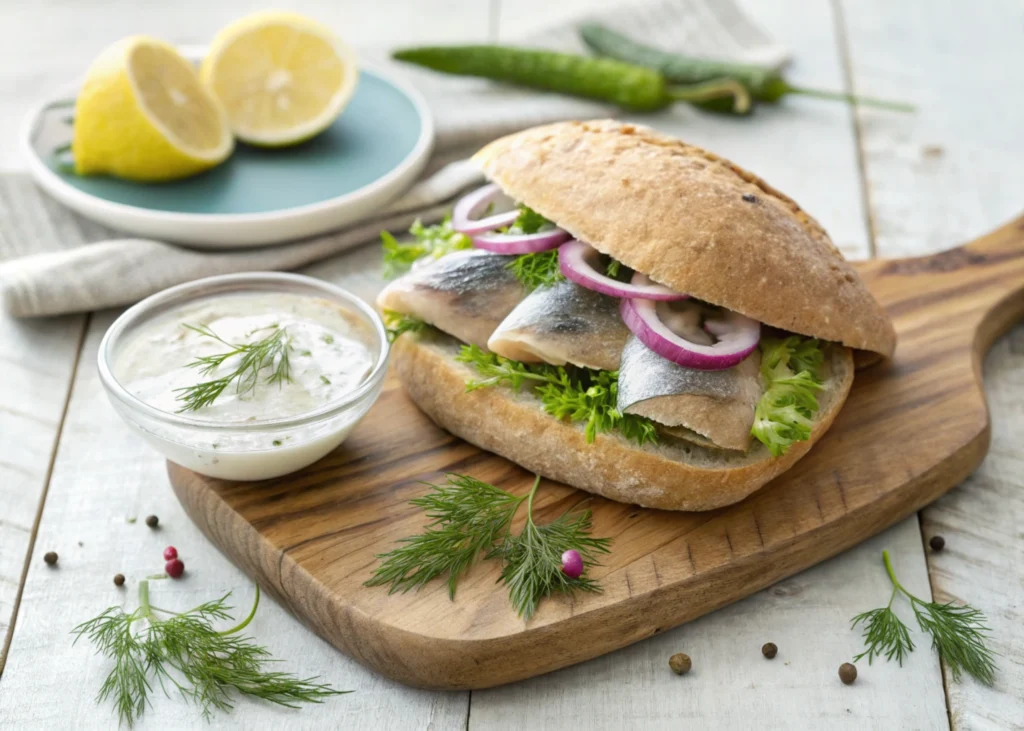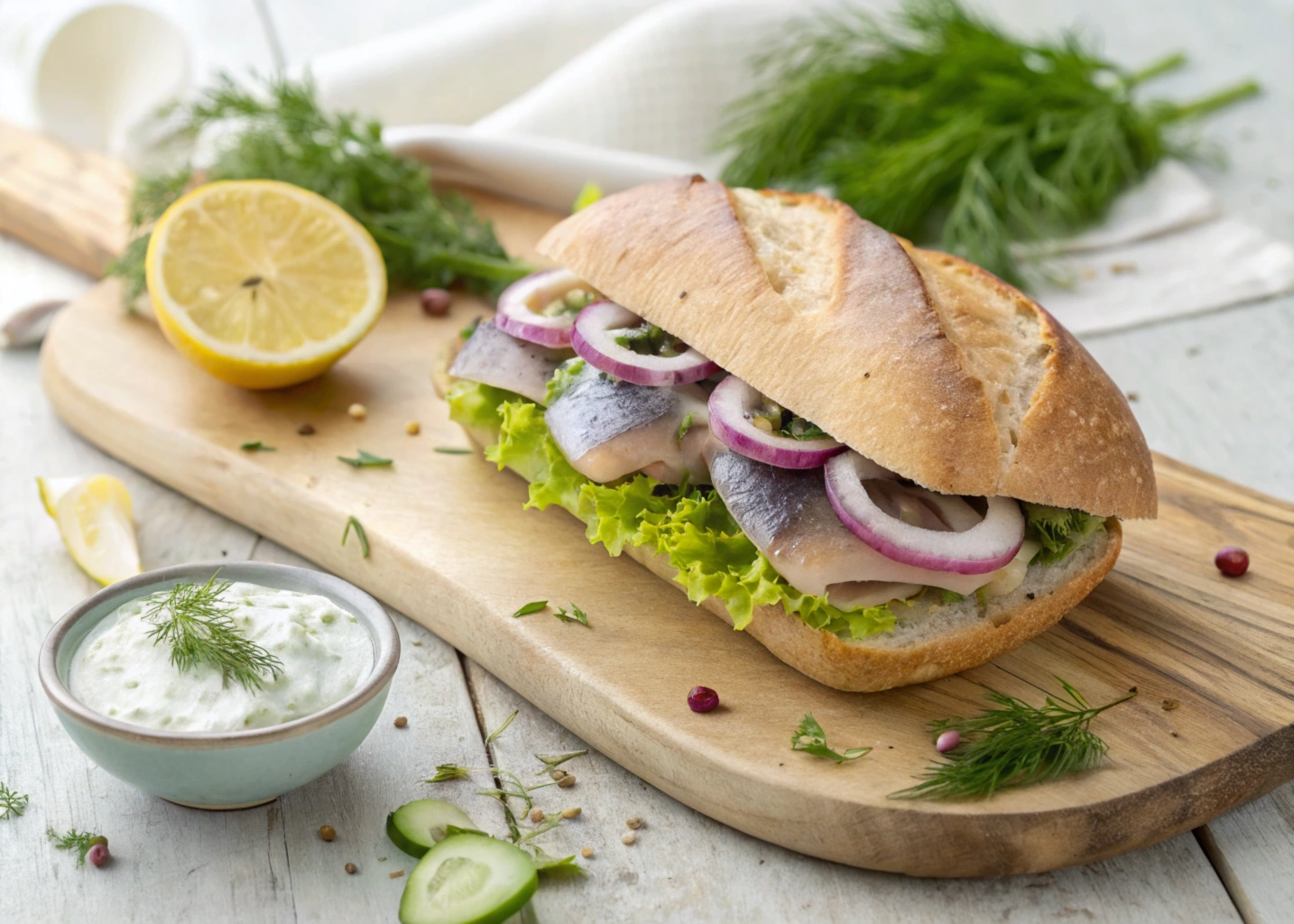Imagine biting into a soft, crusty roll packed with delicate pickled herring, crisp lettuce, tangy onions, and a creamy dollop of sauce. That’s a matjesbrötchen recipe brought to life—a beloved German street food that combines simplicity with unbeatable flavor. This article will take you through the origins, ingredients, preparation steps, and even a few fun variations of this classic dish. Whether you’re a seasoned foodie or just looking for something new to try, this guide will make you feel like you’re strolling the streets of Hamburg, sandwich in hand.
Whether you’re a foodie on the hunt for your next favorite dish or simply curious about German cuisine, this article will transport you to the lively streets of Hamburg, where this sandwich reigns supreme.
So, grab your apron, and let’s get started on your journey to crafting the perfect matjesbrötchen!
Introduction to Matjesbrötchen Recipe
What is Matjesbrötchen?
A matjesbrötchen (pronounced “maht-yess-broht-chen”) is a quintessential German sandwich that highlights matjes herring—a young, delicate, and mildly salted herring fillet. Nestled in a fresh bread roll (brötchen), this sandwich is traditionally adorned with crisp lettuce, finely sliced onions, and a generous dollop of tangy remoulade or dill sauce. Renowned as Germany’s ultimate grab-and-go snack, the matjesbrötchen is portable, satisfying, and packed with an explosion of flavors in every mouthful.
This dish is especially popular in Northern Germany, where fresh fish is a cornerstone of the local cuisine. Locals love enjoying it at seaside fish markets, food stalls, or even during festivals. And let’s be real: the combination of salty fish and soft bread is just chef’s kiss!
Historical Significance in German Cuisine
The origins of matjesbrötchen are deeply tied to Germany’s fishing traditions. Herring has been a staple in the German diet for centuries, especially in coastal areas like Schleswig-Holstein. The introduction of matjes herring, which undergoes a unique curing process, elevated this simple fish into an iconic dish. Over time, the humble matjesbrötchen grew in popularity, becoming a symbol of German street food culture.
Today, it’s a go-to snack for locals and tourists alike. From small harbor towns to bustling cities, you’ll find this sandwich celebrated for its fresh ingredients and rich flavors. Whether paired with a cold beer or enjoyed solo, it’s a dish that brings people together—one bite at a time.
Understanding Matjes Herring for Your Matjesbrötchen Recipe
What Makes Matjes Herring Special in a Matjesbrötchen Recipe?
Matjes herring is the heart of any authentic matjesbrötchen recipe. This young, lightly salted fish is cured in a delicate brine made with vinegar, sugar, and spices, giving it a mild, almost creamy flavor. Unlike other pickled herrings, matjes is tender and less tangy, which makes it the perfect match for soft bread rolls and fresh toppings. Its buttery texture melts in your mouth, creating a sandwich experience like no other.
In German cuisine, matjes herring holds a special place, often celebrated for its versatility. While it stars in many dishes, including salads and appetizers, it truly shines in the classic matjesbrötchen recipe. The balance of flavors—salty, sweet, and tangy—is what makes this fish so popular.
Nutritional Benefits of Matjes Herring in a Matjesbrötchen Recipe
One of the best things about adding matjes herring to your matjesbrötchen recipe is its nutritional value. Packed with omega-3 fatty acids, it’s great for heart health and brain function. Plus, it’s loaded with protein to keep you full and energized. It’s also rich in vitamins D and B12, which are vital for bone health and energy metabolism.
Including matjes herring in your diet isn’t just tasty—it’s a smart choice for a healthier lifestyle. So, when you’re whipping up your next matjesbrötchen recipe, you can feel good about enjoying this flavorful fish.
Essential Ingredients for a Perfect Matjesbrötchen Recipe
Choosing the Right Bread Roll for a Matjesbrötchen Recipe
The bread roll is the foundation of any great matjesbrötchen recipe. You want a roll that’s soft enough to bite into but sturdy enough to hold the toppings. Kaiser rolls, sourdough buns, or rustic multigrain rolls are all excellent choices. The roll’s slight crispiness on the outside should balance the softness of the matjes herring and creamy condiments.
To elevate your matjesbrötchen recipe, consider lightly toasting the bread roll for added warmth and flavor. This simple step enhances the sandwich’s overall appeal.
Fresh Toppings for a Flavorful Matjesbrötchen Recipe
Fresh, high-quality toppings are essential for a standout matjesbrötchen recipe. Crisp lettuce provides a refreshing crunch, while thinly sliced red onions add a zesty tang. For a twist, include pickles or even thin slices of apple for a touch of sweetness.
Want to experiment? Sprinkle some fresh dill or parsley over your toppings to give your sandwich a hint of herbaceous aroma.
Creamy Condiments for Your Matjesbrötchen Recipe
Every matjesbrötchen recipe shines when it includes a creamy component to harmonize all the flavors. Traditional options such as dill sauce, remoulade, or lemon-infused mayonnaise add a rich, tangy element that perfectly complements the salty, tender matjes herring.
For those seeking a bolder twist, a swipe of mustard or a spoonful of horseradish can take the flavor profile to the next level. The sharp contrast between the creamy condiments and the salty herring creates a truly memorable and delightful culinary experience.
With these essential ingredients, you’re well on your way to crafting a matjesbrötchen recipe that’s both delicious and satisfying!

Step-by-Step Preparation Guide for Your Matjesbrötchen Recipe
Preparing the Matjes Herring
First things first: let’s get that matjes herring ready for your matjesbrötchen recipe. If you’re using store-bought matjes, it’s usually pre-marinated and ready to eat. However, giving it a quick rinse under cold water can help reduce excess salt. Pat the fillets dry with a paper towel, then cut them into bite-sized pieces or leave them whole, depending on your preference. If you’re feeling adventurous and want to marinate your own herring, you’ll need fresh, young herring fillets. Marinate them in a mixture of vinegar, water, sugar, and spices like bay leaves and peppercorns for 24 to 48 hours in the fridge. This DIY approach can add a personal touch to your matjesbrötchen recipe, but it does require some planning ahead.
Assembling the Matjesbrötchen
Now comes the fun part—putting it all together! Slice your chosen bread roll in half and, if you’d like, lightly toast it for extra crunch. Spread a generous layer of your preferred condiment on both halves; dill sauce or remoulade works great here. Place a few crisp lettuce leaves on the bottom half of the roll, followed by the prepared matjes herring. Top it off with thinly sliced red onions and any additional toppings you fancy, like pickles or apple slices. Finally, crown your creation with the top half of the roll. Give it a gentle press to hold everything together, and voilà! Your matjesbrötchen is ready to enjoy.
Serving Suggestions
While the matjesbrötchen is delightful on its own, pairing it with some traditional German sides can elevate your meal. Consider serving it alongside a light potato salad or a tangy cucumber salad to complement the flavors of the herring. A cold pilsner or a crisp white wine can also make excellent beverage companions. If you’re hosting a gathering, presenting the matjesbrötchen on a wooden board with garnishes like lemon wedges and fresh herbs can add a rustic touch. And remember, this sandwich is best enjoyed fresh, so dig in right away for the optimal taste experience.
For more delicious recipes, check out our recipe article.
Variations of the Matjesbrötchen Recipe
Regional Twists on the Matjesbrötchen Recipe
Germany’s diverse regions each bring their own flair to the classic matjesbrötchen recipe. In Hamburg, for instance, it’s common to add a slice of pickle for an extra tangy kick. Meanwhile, in Bremen, you might find the sandwich garnished with a sprinkle of chopped chives or even a spoonful of creamy horseradish sauce. These regional variations showcase the versatility of the matjesbrötchen and how local tastes influence its preparation.
Modern Takes on the Classic Matjesbrötchen Recipe
Modern chefs and home cooks have put their creative spin on the traditional matjesbrötchen recipe, experimenting with exciting ingredients and bold flavors. For instance, adding creamy avocado slices brings a rich texture to the sandwich, while a drizzle of spicy sriracha mayo introduces a fiery kick that appeals to adventurous palates. These innovative twists breathe new life into the classic recipe, making it more versatile and appealing to a wider audience. Others have explored using different types of bread, such as whole grain rolls or even pretzel buns, to add a unique spin to the classic dish. These innovations keep the matjesbrötchen exciting and adaptable to various palates.
If you’re interested in trying more seafood sandwich recipes, you might enjoy our Ahi Tuna Recipe or our Shrimp Garlic Recipe -Butter. These recipes offer delicious alternatives that seafood lovers are sure to appreciate.
For more delicious recipes, check out our recipe article.

Tips for the Perfect Matjesbrötchen Recipe
Selecting the Best Ingredients for a Matjesbrötchen Recipe
The key to nailing any matjesbrötchen recipe lies in the quality of your ingredients. Always choose fresh matjes herring from a trusted source—it should have a mild, clean aroma and a smooth texture. When it comes to the bread roll, opt for something freshly baked with a sturdy crust that can hold all the fillings without falling apart. And don’t skimp on the toppings! Crisp, vibrant lettuce and freshly sliced onions can make all the difference.
Another pro tip? Use homemade or high-quality condiments. A freshly made dill sauce or a zesty remoulade will elevate your sandwich from good to exceptional. These little details can really make your matjesbrötchen recipe stand out.
Balancing Flavors and Textures
Creating the perfect matjesbrötchen is all about finding the right balance. The salty, tangy matjes herring pairs wonderfully with creamy sauces and crisp, crunchy toppings. If you find the flavors leaning too salty, try adding a hint of sweetness with thin apple slices or a sweet pickle. On the other hand, if bold flavors are your thing, a sprinkle of fresh dill or cracked black pepper can give your sandwich an extra kick. Don’t forget, experimenting with different ingredients can make your matjesbrötchen recipe truly one-of-a-kind!
Frequently Asked Questions (FAQs)
What is the origin of the matjesbrötchen recipe?
The matjesbrötchen recipe originates from Northern Germany, particularly in coastal towns like Hamburg and Bremen. It’s a traditional street food beloved for its simple yet flavorful ingredients, especially the mild, buttery matjes herring.
Can I use other types of fish in a matjesbrötchen recipe?
While matjes herring is the star of the classic matjesbrötchen recipe, you can experiment with other fish. Smoked salmon or pickled mackerel can be excellent alternatives, though they’ll give your sandwich a slightly different flavor profile.
How should I store leftover matjesbrötchen?
Ideally, a matjesbrötchen should be eaten fresh. However, if you have leftovers, wrap them tightly in plastic wrap and store them in the fridge for up to a day. Keep in mind that the bread may lose some of its texture, so it’s best to assemble the sandwich just before eating.
For more tips and variations, check out other seafood recipes on Nourishous Recipes.
Conclusion
The matjesbrötchen recipe isn’t just a sandwich; it’s a bite of German culinary tradition. Whether you stick to the classic version or get creative with modern twists, this dish is sure to impress your taste buds. With its perfect balance of flavors—salty, tangy, creamy, and crunchy—it’s no wonder this recipe has stood the test of time.
So, why not bring a little bit of Germany into your kitchen? Gather your ingredients, follow the steps, and enjoy this delicious and easy-to-make sandwich. Once you’ve tried it, you’ll understand why the matjesbrötchen recipe is so beloved.


1 thought on “Matjesbrötchen Recipe: A German Culinary Delight”